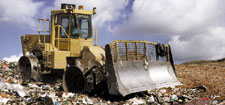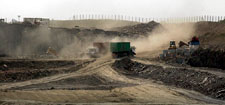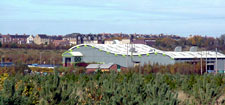Waste
The disposal of waste in County Durham in the past has been largely to landfill due to the abundance of capacity in abandoned quarries and clay pits. This has discouraged the development of more sustainable methods of waste management and encouraged large quantities of waste to be imported from nearby conurbations. The increasing emphasis placed on recycling and recovery of waste and the requirement to reduce waste going to landfill under the EC Landfill Directive are bringing about a significant change in the way waste is managed.
Waste management and disposal facilities can bring changes to the rural landscape in a number of ways.
- Natural topography may be permanently damaged by land-filling or land-raising.
- Geological exposures in old quarries may be concealed.
- Mature landscapes and landscape features like hedgerows and hedgerow trees may be lost.
- The rural character of the landscape may be eroded by the presence of industrial features – operational and tipping areas, litter-trap fencing, stockpiles and screening mounds, processing plant and buildings
- The tranquillity of the surrounding countryside may be weakened by noise and light pollution and by increased levels of lorry traffic on local roads.
- Local distinctiveness may be weakened by insensitive restoration.
- Old mineral workings, derelict or contaminated land may be restored by landfilling.
- Organic wastes may be returned to land to restore or increase soil fertility.
- New landscape features can be created on restoration that contribute to the local landscape – ponds and wetlands, native woodlands, species rich grasslands, heathland, hedges and walls.
There will be a continued need for new waste management and disposal facilities ranging from landfill sites to waste digesters. It is important that these developments do not adversely affect valued attributes of the landscape, and where possible contribute to wider goals like restoring biodiversity.
Issues and Objectives
Planning for New Development
The adopted County Durham Waste Local Plan sets out the detailed local planning policies and proposals that guide the management of waste. It will be replaced by the emerging County Durham Minerals and Waste Local Development Framework. Its informing principles will be to minimise the amount of waste produced and to view waste as a resource from which value can be extracted through recycling or recovery, before disposal of the residues. The Landscape Assessment and Strategy will be used to inform both the selection and design requirements of sites that come forward through the Waste Local Plan process.
Objectives
- To inform Local Development Framework policies and allocations.
Guiding New Development
The impacts of new waste facilities will be strongly influenced by the way sites are selected, designed, managed and restored. The Landscape Character Assessment and Strategy provides baseline information on landscape character, and broad objectives which can inform those processes. New technologies bring new challenges, both in terms of accommodating new types of development, and in integrating waste and land management objectives – for example in returning organic wastes or residues to land. There is a need for further design guidance on waste development and particularly for these newer technologies. A Supplementary Planning Document is currently being prepared (2007) as part of the Minerals & Waste LDF which will give further guidance on landscape issues.
Objectives
- To inform and support the development of a Supplementary Planning Document on Minerals and Waste.
Landfill
Approved landfill capacity in the County has been declining and is currently low in some areas and for particular types of waste. The emphasis placed on protecting water resources by the Environment Agency in the recent The Location and Impact Assessment of Landfill Sites may result in new sites being required off the Permian limestone aquifer which in the past has presented most opportunities in abandoned quarries. New landfill or land-raise sites may therefore be proposed on greenfield sites. Some existing landfill sites are visually intrusive and unsightly. Their effects on the locality could be improved in places by on-site improvements and off-site planting.
Objectives
- To ensure that new landfill or land-raise proposals are in keeping with the character of the landscape and contribute to the landscape strategy for the area.
- To encourage improvements to the appearance of active landfill sites.
Restoration and Aftercare
Restoration can offer opportunities to meet wider goals like enhancing landscape character and biodiversity or increasing woodland cover. Restoration design is often constrained by the need to accommodate settlement, leachate and gas control, or energy recovery. Restoration and aftercare works may need to be phased over a long period to achieve satisfactory results. This Strategy identifies broad objectives for local landscapes which should be used, together with the Landscape Guidelines and other strategies like the Durham Biodiversity Action Plan, to inform the after-use and detailed design of restored sites.
Objectives
- To encourage the creative restoration of waste disposal sites to restore or enhance landscape character and biodiversity and bring benefits to local communities.
Legacies from the Past
Reclamation practices on many former waste disposal sites in the County were significantly below modern standards and some sites were restored with little regard to landscape character. Opportunities to improve the landscape quality of former waste disposal sites may be constrained by the lack of adequate capping materials or ongoing operational and monitoring requirements.
Objectives
- To secure improvements to the restoration of old waste disposal sites where technically feasible.
Specification of Recycled Materials
There are many opportunities for using recycled materials in landscaping works. The use of reclaimed stone or brick, secondary aggregates, recovered soils and organic composts or street furniture manufactured from recycled materials can help reduce the amount of waste going to landfill.
Objectives
- To promote the use of re-used or recycled material in landscaping works.



